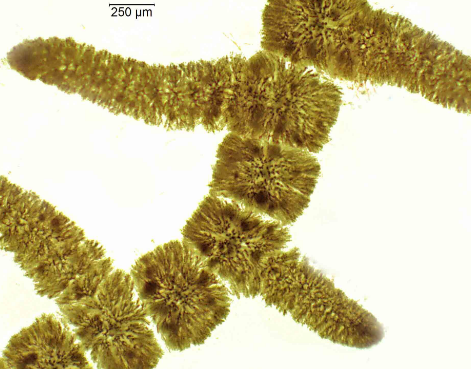Batrachospermum Occurrence:- (1) Batrachospermum is fresh water alga. (2) It is found in clear, cool, and running streams. (3) Deepwater plants are dark violet or reddish in color. But the shallow-water species are olive green. (4) The intensity of light changes the color of pigments. (5) The thallus is attached to the substratum. Vegetative structure (1) The thallus of an adult plant is soft, thick, filamentous. (2) It is freely branched and gelatinous. (3) The central axis is made up of a single row of large cells. Whorls of branches of limited growth are developed on this axis. (4) These branches are filamentous and dichotomously arranged. (5) The main axis is corticated. It consists of a row of elongated cylindrical cells....
Batrachospermum
Occurrence:-
(1) Batrachospermum is fresh water alga.
(2) It is found in clear, cool, and running streams.
(3) Deepwater plants are dark violet or reddish in color. But the shallow-water species are olive green.
(4) The intensity of light changes the color of pigments.
(5) The thallus is attached to the substratum.
Vegetative structure
(1) The thallus of an adult plant is soft, thick, filamentous.
(2) It is freely branched and gelatinous.
(3) The central axis is made up of a single row of large cells. Whorls of branches of limited growth
are developed on this axis.
(4) These branches are filamentous and dichotomously arranged.
(5) The main axis is corticated. It consists of a row of elongated cylindrical cells.
(6) It is differentiated into nodes and internodes.
(7) There are two types of branches that arise from the nodes:
Branches of limited growth
Branches of unlimited growth
Branches of limited growth
(1) These arise in whorls from the nodes.
(2) These grow for some time, and then these end in long hairs.
(3) Their cells arranged like beads. All of the branches of a whorl are equal in length.
(4) Therefore, they form a globose structural led glomerule.
Branches of unlimited growth
(1) These branches arise from the cells of branches of limited growth.
(2) These are also differentiated into nodes and internodes and are corticated. branches of limited - growth arise from their nodes.
(3) Their cells are comparatively longer.
Cell structure:-
(1) The cells are uninucleated. Their cells are °minded by two-layered cell walls.
(2) Outer layer is composed of pectic compounds and the inner layer is composed of cellulose.
(3) Pit connections are present between cells.
(4) Cell has many irregular chromatophores.
(5) Its pigments are phycoerythrin, phycocyanin, and other photosynthetic pigments like chlorophyll a,
chlorophyll b, Carotene, and Xanthophyll.
(6) Each chromatophore has a single pyrenoid.
(7) The central cells of the axis are connected by a cytoplasmic connection.
(8) Reserved food in the trial is Floridian starch
 |
| Batrachospermum internal |
Sexual reproduction:-
Sexual reproduction is oogamous. The plant may be homothallic and heterothallic
Antheridia or spermatangia
(1) The male sex organs are antheridia or spermatangia.
(2) They are small unicellular structures.
(3) Mature spermatogonium is thick-walled, colorless, and rounded. Spermatangia are produced singly,
in pairs in groups of four.
(4) The protoplast of antheridium changes into a single non-motile spermatium.
(5) The antheridial wall ruptures and releases spermatium.
Carpogonia:
(1) The female reproductive organ is carpogonia.
(2) Carpogonia are unicellular. It consists of an elongated cell present at the base.
(3) The upper larger portion is called trichogyne.
(4) The lower globular portion is called microphore.
(5) The branch bearing the carpogonium is called ascocarp. Ascocarp consists of four cells.
(6) The terminal cell form; polonium. Egg nucleus is present in mirophore.
(7) Egg nucleus is surrounded by some cytoplasm and it changes into an egg. trichogyne is separated from the microphone by a constriction.
(8) Trichogyne is used for receiving sperm.
Cystocarp formation:
(1) A protuberance is produced on the carpogonium.One daughter nuclei migrate into this protuberance.
(2) Septa separate this protuberance from carpogonium
(3) New protuberances formed on carpogonium. The remaining nuclei migrate to them.
(4) These protuberances divide and form gonimoblast filament.
(5) The carpogonium with gonimoblast P laments are called cystocarp.
Formation of carpospores:
(1) The terminal cell of gonimoblast Hament produces non-motile carpospore.
(2) The carpospore is formed in the form of a naked mass of protoplast.
Formation of chantransia stage
(1) Carpospore separates from the filaments and secretes the cell wall. It settles in a suitable - environment.
(2) Then it becomes a pod of parenchymatous tissues. A small outgrowth is formed from one side of the
carpospore.
(3) The cut growth is cut off by the formation of the septum. It divides transversely many times to form prostrate filaments.
(4) This sage of thallus resembles another alga called cha itransia.
(5) Therefore, this stage of Batrachospermum is called Chantransia stage. It is a juvenile stage.
(6) This stage reproduces by for action of monospores.
Formation of monospores:
(1) The terminal cells of filaments form monospore.
(2) Monospores are non-motile and uninucleate.
(3) They are produced in monosporangia. Some cells of the (4)Chantransia stage become swollen.
(5) They become spherical and oblong to form monosporangia.
(6) The content of each monosporangium develops into a single uninucleate spore called monospore.
(7) These spores librates and again develop chantransia stage. The terminal cells of the lower branches of chantransia function as apical cells.
(8) They give rise to adult plants. It is generally believed that chantransia filament forms the prostate system and filament proper forms the system alternation of generation.

Comments
Post a Comment
Thanks